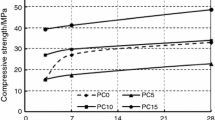Abstract
Ground granulated blast furnace slag (GGBFS or “slag”) is a by product of the steel industry and is often used in combination with ordinary Portland cement (OPC) as a binder in concrete. When concrete is exposed to high temperatures, physical and chemical transformations lead to significant loss of mechanical strength. Past studies have reported changes in concrete where OPC is 100% of the binder, but there is a lack of published data on slag blended cements. This work provides better understanding of how slag blended cement pastes behave when exposed to high temperatures, when the critical transformations occur, and what the consequences in the structure of these pastes are. Thermogravimetric analysis made it possible to identify when the transformations occurred and the changes in mechanical strength in the cement paste. A unique outcome of this work is the lower damage presented by slag blended cements after exposure to high temperatures






Similar content being viewed by others
References
Lea F, Stradling R (1922) The resistance of fire of concrete and reinforced concrete. Engineering 144: 341–344, 380–382
Handoo SK, Agarwal S, Agarwal SK (2002) Physicochemical, mineralogical, and morphological characteristics of concrete exposed to elevated temperatures. Cem Concr Res 32:1009–1018
Harmathy TZ (1968) Determining the temperature history of concrete constructions following fire exposure. ACI J 65(11):959–964
Harmathy TZ (1993) Fire safety design & concrete. Longman Scientific & Technical
Matesova D, Bonen D, Surenda PS (2006) Factors affecting the resistance of cementitious materials at high temperatures and medium heating rates. Mater Struct 39:919–935
Khoury GA, Dias WPS, Sullivan PJE (1990) Mechanical properties of hardened cement paste exposed to temperatures up to 700°C. ACI Mater J 87:160–166
Castellote M, Alonso C, Andrade C, Turrilas X, Campo J (2004) Composition and microstructural changes of cement pastes upon heating, as studied by neutron diffraction. Cem Concr Res 34:1633–1644
Khoury GA (1992) Compressive strength of concrete at high temperatures: a reassessment. Mag Concr Research 44(161):291–309
Petzold A, Rohrs M (1970) Concrete for high temperatures, 2nd edn. Maclaren and Sons Ltd, London
Xiao J, Xie M, Zhang C (2006) Residual compressive behaviour of pre-heated high-performance concrete with blast-furnace-slag. Fire Saf J 41:91–98
Georgali B, Tsakiridis PE (2005) Microstructure of fire-damaged concrete. A case study. Cem Concr Composites 27(2):255–259
Khoury GA, Grainger BN, Sullivan PJE (1985) Transient thermal strain of concrete: literature review, conditions within specimen and behaviour of individual constituents. Mag Concr Res 37(132):131–144
Carette GG, Painter KE, Malhotra VM (1982) Sustained high temperatures effect on concretes made with normal Portland cement, normal Portland cement and slag, or normal Portland cement and fly ash. Concr Int Design and Constr 4(7):41–51
Alarcon-Ruiz L, Platret G, Massieu E, Ehrlacher A (2005) The use of thermal analysis in assessing the effect of temperature on a cement paste. Cem Concr Res 35:609–613
Saito M, Kawamura M (1989) Effect of fly ash and slag on the interfacial zone between cement and aggregate. In: Malhotra VM (ed) Paper presented at the 3rd international conference on Fly Ash, Silica Fume, Slag, and Natural Pozzolans in Concrete. Trondheim, Norway, ACI SP 114
Larbi JA, Bijen JM (1992) Effect of mineral admixtures on the cement paste-aggregate interface. In: Malhotra VM (ed) Paper presented at the 4th CANMET/ACI international conference on Fly Ash, Silica Fume, Slag, and Natural Pozzolans in concrete. Istanbul, Turkey, ACI SP-132
Nilsen U, Sandberg P, Folliard K (1992) Influence of mineral admixtures on the transition zone in concrete. In: Maso JC (ed) Paper presented at the RILEM international conference on interfaces in cementitious composites. E & FN Spon, London
Hooton RD (1997) Slag binders for enhanced performance of concrete. Paper presented at the international seminar on technical and environmental advantages of concrete containing Fly Ash and Slag, Ash Development Association of Australia, Australasian Slag Association, and Institution of Engineers, Sydney, Australia, 22 August 1997
Scrivener KL (1989) The microstructure of concrete. Paper presented at the materials science of concrete I, The American Ceramic Society, Westerville, Ohio
Acknowledgments
The authors gratefully acknowledge the Australian Research Council Discovery Grant No. DP0558463 for this research project.
Author information
Authors and Affiliations
Corresponding author
Rights and permissions
About this article
Cite this article
Mendes, A., Sanjayan, J. & Collins, F. Phase transformations and mechanical strength of OPC/Slag pastes submitted to high temperatures. Mater Struct 41, 345–350 (2008). https://doi.org/10.1617/s11527-007-9247-8
Received:
Accepted:
Published:
Issue Date:
DOI: https://doi.org/10.1617/s11527-007-9247-8




